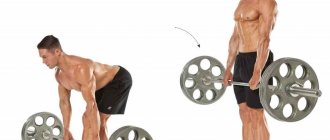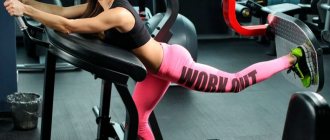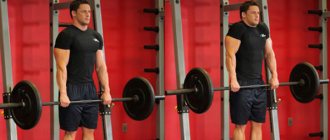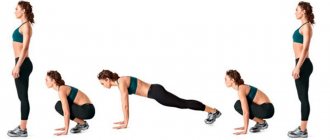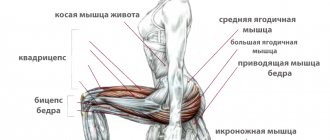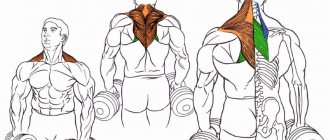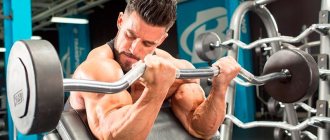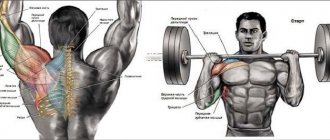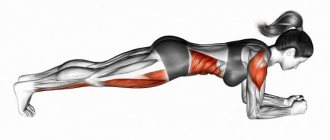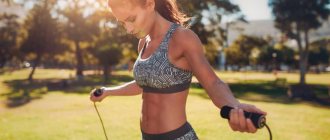The standing biceps curl is accessible to everyone – from beginners to professionals. It has remained a major movement for many people for decades. It is technically simple, can be performed with heavy weights, and has even become a competitive movement. Yes, some people compete in this exercise and even win international competitions. There are two main variations of the movement - a straight lift and an exercise with a curved barbell. The latter is done to relieve the load on the hands.
Introduction
Biceps are a part of the body that many unreasonably consider to be the main one and often spend too much time training them, forgetting about other muscle groups. You can often see guys in the gym who pump their biceps two or even three times a week, stroking their pride with the misconception that “the more often you pump, the faster it will grow.” But we are not talking about them now. Here we will describe the most effective exercises for the biceps, as well as for the forearms.
In this article we will look at the muscles that are somehow involved in flexing the elbow joint. These are primarily the biceps brachii muscle (biceps), brachialis muscle (brachialis) and forearm muscles. As we already understood, biceps are needed to bend the arms at the elbows. The muscles of the forearms help with the work of the wrists. Accordingly, training the biceps and brachialis consists of all kinds of arm curls. The forearms are trained by flexing and extending the wrists.
Working muscles
Since the exercise is designed to work the biceps, two muscles can be distinguished.
- Double-headed , which consists of two beams, large and small. This is what gives the biceps a beautiful appearance.
- And since the work occurs in the elbow joint, it means that the brachialis . It is located under the biceps muscle and is smaller in size. But at the same time it works equally with her. A well-developed brachialis helps visually enlarge the biceps.
Standing biceps curl
This barbell biceps exercise targets the middle, top, and bottom of the biceps, as well as the upper part of the forearm. Basic exercise, best for building mass and strength. Recommended for everyone, from beginner to experienced athlete at the very beginning of biceps training.
Exercise technique
1. Place the desired weight on the barbell. Stand straight, feet shoulder-width apart, feet parallel, toes slightly to the sides. Take the barbell shoulder-width apart with an underhand grip. 2. In the starting position, the back maintains a natural curve, the head looks forward. The arms are straightened, but not locked at the elbows. The barbell in your hands is at hip level. 3. Take a deep breath and, holding your breath, bend your elbows. At the top point, the bar should be at the level of your upper chest. 4. You can exhale after overcoming the most difficult section of the amplitude. Then immediately, without delay, lower the barbell to its original position. 5. You shouldn’t linger at the bottom point either. As soon as the bar reaches the lowest point, immediately change the direction of its movement.
Technique tips
- Using a standard shoulder-width underhand grip is the most effective way to effectively work both the biceps and brachialis.
- Using a non-standard overhand grip, shoulder-width apart, is the most effective way to effectively work the brachioradialis muscle.
- Throughout the entire approach, keep your back straight and do not sway. By pushing your body forward or backward to help lift the weight, you take the stress off your biceps.
- During the positive phase (rising), the elbows are strictly fixed at the sides. There is no need to bring them forward, otherwise the load from the biceps goes to the front deltoids.
- There is no point in using too much weight in the exercise. It will provoke you to swing and throw the barbell by inertia, which will reduce the effectiveness of the exercise.
- Too much weight will also significantly reduce the range of motion of the barbell, which will prevent you from lifting it high enough at the top.
- A variation with an angled grip is possible. For this, an EZ-bar or W-bar is used (see article). The more the hand is turned with the thumb up, the more the brachialis is activated.
- A variation with a parallel grip is possible. For this, an oval bar is used (see ibid.). In the position where the palms are facing each other, the brachialis is pumped efficiently.
- A variation is possible with an underhand grip wider than shoulder width. In the case of a straight bar, this grip allows you to effectively work the inner head of the biceps.
- A variation is possible with a grip from below, narrower than the shoulders. In the case of a straight bar, this grip allows you to effectively work the outer head of the biceps.
Standards for training in powerlifting
Powerlifting is a sport aimed at lifting a barbell in various movements. The classic version involves three movements: bench press, deadlift and squats, but there are other variations, such as strict biceps curls.
The standards will differ depending on gender, weight, and the federation in which the athlete competes. For example, in WRPF the standards for men are as follows:
| Athlete's weight in kilograms | Projectile mass (3, 2, 1 category, KMS, MS, MSMK) |
| 52-56 | 25, 27,5, 30, 32,5, 40, 47,5 |
| 60-67,5 | 32,5, 35, 37,5, 40, 47,5, 55 |
| 75-82,5 | 42,5, 45, 47,5, 50, 57,5, 65 |
| 90-100 | 55, 57,5, 60, 62,5, 70, 77,5 |
| 100-125 | 65, 67,7, 70, 72,5, 80, 87,5 |
| 125+ | 75, 77,5, 80, 82,5, 90, 97,5 |
The movement must be performed once, but with strict adherence to the correct technique. For women, the standards are slightly different:
| Athlete's weight in kilograms | Projectile mass (3, 2, 1 category, KMS, MS, MSMK) |
| Up to 44 | 12,5, 15, 17,5, 20, 25, 32,5 |
| 48 | 15, 17,5, 20, 22,5, 27,5, 35 |
| 52 | 17,5, 20, 22,5, 25, 30, 37,5 |
| 56 | 20, 22,5, 25, 27,5, 32,5, 40 |
| 60 | 22,5, 25, 27,5, 30, 35, 42,5 |
| 67,5 | 25, 27,5, 30, 32,5, 37,5, 45 |
| 75 | 27,5, 30, 32,5, 35, 40, 47,5 |
| 82,5 | 30, 32,5, 35, 37,5, 42,5, 50 |
| 90 | 32,5, 35, 37,5, 40, 45, 52,5 |
| Over 90 | 35, 37,5, 40, 42,5, 47,5, 55 |
Standards are assigned when movements are performed at competitions and there are judges of a certain rank. Specific requirements are set by each federation individually.
Standing dumbbell curls
This biceps exercise with dumbbells targets the middle, top, bottom, brachialis and brachioradialis muscles. This is a basic exercise used to build mass and strength. Recommended for everyone, from beginner to experienced athlete at the beginning of biceps training.
Exercise technique
1. Select dumbbells of the desired weight and hold them in both hands with a neutral grip (palms facing each other). Feet hip-width apart, back straight. The head looks ahead. 2. Take a deep breath and, holding your breath, lift the dumbbells to your shoulders. The upward movement of the dumbbells is accompanied by a turn of the hands. At the top point, the palms face the shoulders. 3. You can exhale after passing the most difficult section of the amplitude. Then immediately, without delay, return the dumbbells to their original position by turning the hands back. 4. At the bottom point of the palm, look at the side of the thigh. As soon as they reach this position, immediately change their direction of movement.
Technique tips
- Make sure to keep your elbows on the sides of your body at all times. By pushing them forward, you transfer the load to the front deltoids, which reduces the effectiveness of the exercise.
- The arms are fully straightened at the lowest point, but not to the point of locking at the elbow joints. Fully straightening the arms places stress on the elbow, which can lead to injury.
- There is no point in keeping your palms turned back in the original position. In this position, the biceps tendons become twisted and the strength of the biceps is significantly reduced.
- To maximize your biceps contraction, at the top of the exercise, try to supinate (rotate away from you) your wrist as much as possible.
- By holding your breath, you help yourself stabilize your core position, and you can develop significantly more force while lifting the dumbbells.
- Don't rock your body forward or back in an attempt to help you lift the weight. This will significantly reduce the effectiveness of the exercise.
- Do not use excessive weight in the exercise. Firstly, it will not allow you to work in full amplitude, and secondly, at the moment of turning your hand, you can injure your wrist.
- Throughout the entire approach, the hands remain motionless. Secure them at the very beginning, do not bend or straighten them.
- A variation of alternate lifting of dumbbells with the left and right hands is possible. However, with this variation, you will bend over and swing your body, which will reduce the load on the biceps.
- A variation of performing the exercise with both hands at the same time is more preferable. This way the load and center of gravity are distributed evenly, which eliminates unnecessary body movements.
Principles and features of training
Those who have only recently decided to take care of their own body are primarily interested in the biceps training complex. The main query on the Internet today is “how to quickly pump up your hands”? Any professional will confidently answer that progress primarily depends on patience, effort and time. The technique of performing exercises in a complex manner is also important.
Only if you follow the basic principles and rules of training can you easily and in a short time become the owner of well-pumped muscles:
- It is recommended to work out the biceps several times a week. The number and content of training are determined individually, depending on the health and physical condition of the person. There is no point in experimenting without experience and knowledge. It is best to come to the gym and consult with a specialist. A professional trainer will assess your physical capabilities over the course of several sessions and select the most suitable exercises for your arms.
- To perform the exercises, you must use sports equipment. At first, dumbbells or an empty barbell are enough. In the future we increase the load. We are adding new types of exercise equipment with hanging weights, weights, etc. to the complex.
- Today there is one basic exercise for pumping up the biceps - pull-ups on the bar with a narrow reverse grip. It is important to remember and understand that the biceps muscle is actively involved in working out the entire spinal muscular corset. For this reason, they always try to add this exercise to the back day, supplementing it with a couple of isolating elements.
- When selecting the weight and intensity of the load, it should be taken into account that the biceps is not the largest muscle. Therefore, serious increased loads are not suitable for it. Otherwise, there is a high probability of severely injuring your hand.
Among the features of training with exercises for the biceps muscle of the arm:
- Experienced athletes can train their biceps every day. For beginners there is a limit of 1-2 classes per week. The rest of the time is spent restoring muscles and preparing for new physical activity. If you work beyond your strength, there will be no positive dynamics.
- To increase muscle mass, 8-12 repetitions of the exercise are enough, and to increase strength indicators – 5-8. The duration of one training set is on average 60 seconds. A maximum of three sets are allowed per session.
- In order to avoid muscle addiction, it is recommended to change the structure of classes every 2 weeks, remove or add new elements, and increase the level of difficulty. Regular adjustments to the program ensure gradual progress.
- Maximum pumping of the biceps muscle is possible as a result of high-intensity training. If you have enough physical data, you should immediately move on to a similar training format.
- As part of split training, a combination of exercises to work the biceps with triceps, forearms, shoulders, back and chest is allowed.
- We do not allow any defects under any circumstances. If during the process of performing a complex there is a feeling that the technique is broken or there is simply not enough strength to complete it, you need to immediately finish the set and return to it later after a detailed analysis of the errors.
Seated dumbbell curls
This biceps exercise targets the middle, brachialis, and brachioradialis muscles. A formative exercise, used to build strength and thicken the shape of these muscles. Recommended for everyone, from beginner to experienced athlete in the middle of a biceps workout.
Exercise technique
1. Select dumbbells of the desired weight and hold them in both hands with a neutral grip (palms facing each other). 2. Sit on the edge of the bench. In the starting position, legs are hip-width apart, feet are parallel, and the back is straight. The head looks ahead. 3. Take a deep breath and, holding your breath, lift the dumbbells to your shoulders. The upward movement of the dumbbells is accompanied by a turn of the hands. At the top point, the palms face the shoulders. 4. You can exhale after passing the most difficult section of the amplitude. Then immediately, without delay, return the dumbbells to their original position by turning the hands back. 5. At the bottom point, the palms face each other. As soon as they reach this position, immediately change their direction of movement.
Technique tips
- Do not sit across the bench, otherwise the dumbbells will touch the bench at the bottom point and you will not be able to fully extend your arms.
- Don't lean forward or sway. All movement occurs exclusively at the elbow joint. Keep your back locked throughout the entire approach.
- Holding your breath while doing the exercise not only helps you stabilize your position on the bench, but also helps you develop significantly greater force.
- The elbows are fixed at the sides throughout the entire approach. By raising your elbows at the top of the dumbbell movement, you transfer the load from the biceps to the front deltoids.
- Lifting dumbbells at the same time is preferable to alternate lifting. This way the load and center of gravity are distributed evenly, which eliminates unnecessary body movements.
- Don't use dumbbells that are too heavy. They will not allow you to lift the dumbbells to their full amplitude, which will significantly reduce the effectiveness of the exercise.
Main conclusions
Before pumping up your biceps, you should do a warm-up, as well as other exercises, if they are planned for this training day. It is better to train the biceps at the end or together with the triceps, combining them into a general arm workout.
The technique for performing the movement is simple, but requires a little practice. It is better to start with a small weight, gradually increasing it.
Lifting the barbell is carried out with the first movement, as it works the entire muscle at once, after which isolated movements are added.
Dumbbell curls at an angle
This exercise for the biceps muscles involves the middle and lower part of the biceps, the brachialis and the brachioradialis muscle. A formative exercise, used to build strength and thicken the shape. Recommended for advanced and more experienced athletes in the middle of a biceps workout.
Exercise technique
1. Select dumbbells of the desired weight and hold them in both hands with a neutral grip (palms facing each other). 2. Adjust the backrest to an angle of 45 degrees and sit on the bench. In the starting position, legs are hip-width apart, feet are parallel, and the back is straight. The head looks ahead. 3. Take a deep breath and, holding your breath, lift the dumbbells to your shoulders. The upward movement of the dumbbells is accompanied by a turn of the hands. At the top point, the palms face the shoulders. 4. You can exhale after passing the most difficult section of the amplitude. Then immediately, without delay, return the dumbbells to their original position by turning the hands back. 5. At the bottom point, the palms face each other. As soon as they reach this position, immediately change their direction of movement.
Technique tips
- To prevent you from sliding down the bench while lying down, also raise the saddle of the machine to a slight angle.
- If the raised saddle forces you to spread your legs wide and this interferes with the movement of the dumbbells, lift your legs off the floor and cross them together on the saddle.
- Holding your breath in this position is extremely important, since lifting your legs off the floor will help stabilize your body on the bench as much as possible.
- Do not swing your arms or throw dumbbells by inertia. All movement occurs exclusively in the elbow joints, the rest of the body is motionless.
- The elbows are fixed at the sides throughout the entire approach. By raising your elbows at the top of the dumbbell movement, you transfer the load from the biceps to the front deltoids.
- Lifting dumbbells at the same time is preferable to alternate lifting. It allows you to eliminate body movements and concentrate as much as possible on contracting your biceps.
- Don't use dumbbells that are too heavy. They will not allow you to lift the dumbbells to their full amplitude, which will significantly reduce the effectiveness of the exercise.
Recommendations
- Choose an appropriate weight to eliminate any use of accessory muscles.
- Focus specifically on contracting and stretching your biceps.
- Do not lift weights using inertia. Only slow and controlled movements are the key to muscle growth.
- Elbows should be pressed to the body. There is no need to lift them up while lifting. This will transfer the entire load from the biceps to the front deltoids.
- Try to bring your shoulder blades as close as possible to each other.
- Press the rear delts against the wall or floor. Note: It is clear that you will not be able to achieve full contact with them, so just press them as much as possible.
- Don't raise your shoulders while moving.
- Although this exercise is isolated, it can be performed both at the beginning and at the end of training as a hammering exercise.
- Do not rush to quickly increase the weight of the weight, as your forearms may not keep up with the growth of your biceps.
- Work for the maximum number of times. Failure training is best for developing biceps.
Following all the rules and working out the execution technique. You will be able to achieve phenomenal success. Your biceps will become large and sculpted, the main thing is to move gradually towards this goal.
Good luck to everyone in your training!
Dumbbell bicep curl “Hammer”
This exercise for biceps with dumbbells involves the lateral part of the biceps, brachialis and brachioradialis muscles. A formative exercise, used to thicken the biceps and forearm. Recommended for everyone, from beginner to experienced athlete in the middle of a biceps workout.
Exercise technique
1. Select dumbbells of the desired weight and hold them in both hands with a neutral grip (palms facing each other). Feet hip-width apart, back straight. The head looks ahead. 2. Take a deep breath and, holding your breath, lift the dumbbell to your shoulder. The upward movement of the dumbbell should not be accompanied by any rotation of the hand. At the top point, the palm remains in the same position. 3. You can exhale after passing the most difficult section of the amplitude. Then immediately, without delay, return the dumbbell to its original position at hip level. 4. At the bottom point, the palms face each other. As soon as one dumbbell returns to the starting position, immediately begin moving up with the other dumbbell.
Technique tips
- Make sure to keep your elbows on the sides of your body at all times. By lifting them forward, you transfer the load to the front deltoids, which reduces the effectiveness of the exercise.
- The arms are fully straightened at the lowest point, but not to the point of locking at the elbow joints. Fully straightening the arms places stress on the elbow, which can lead to injury.
- By holding your breath, you help yourself stabilize your core position, and you can develop significantly more force while lifting the dumbbells.
- Don't rock your body forward or back in an attempt to help you lift the weight. This will significantly reduce the effectiveness of the exercise.
- Do not use excessive weight in the exercise. It will not allow you to work at full amplitude, which will significantly reduce the effectiveness of the exercise.
- Throughout the entire approach, the hands remain motionless. Secure them at the very beginning, do not bend, straighten or unfold them.
- A variation of the exercise with both hands at the same time is possible. It allows you to eliminate unnecessary movements of the body and concentrate as much as possible on bending your arms.
EZ-barbell curl on Scott bench
This biceps exercise with a barbell targets the middle and bottom. An isolating exercise, used to lengthen the lower part of the biceps and raise its peak. Recommended for athletes of intermediate level and above in the middle of a biceps workout.
Exercise technique
1. Adjust the height of the desk so that its upper edge rests against your armpits, your back is straight, and your body position remains fixed throughout the entire approach. 2. Take an EZ bar (or W bar), place it on the bench supports and collect the desired weight on it. Hold the barbell shoulder-width apart. Sit down so that your triceps are pressed firmly against the desk. 3. In the starting position, the back is straight, the elbows are on the desk, the arms with the barbell are straightened, but not to the point of locking in the elbow joints. 4. Take a deep breath and, holding your breath, lift the barbell up. At the top point it should be at chin level. 5. You can exhale after overcoming the most difficult section of the amplitude. Then immediately, slowly, return the bar to its original position. 6. At the bottom point, the arms are fully straightened again, and the barbell changes its direction of movement without delay.
Technique tips
- Throughout the entire approach, your elbows should be pressed tightly to the desk. By tearing your elbows off, you severely overload the joints, which can lead to injury.
- Make sure that at the lowest point your arms do not extend until your elbow joints lock. Locking is dangerous not only for the elbows, but also for the biceps ligaments.
- Holding your breath while performing the exercise helps not only keep your back straight, but also develop significantly greater force while lifting the barbell.
- Keep your body still throughout the entire approach. Adjust your seat and desk so that you don't have to lift your butt off the bench or your elbows off the desk.
- If possible, use a Scott bench to perform the exercise while standing. This way you can better fix your posture and avoid unnecessary body movements.
- To maximally work out your biceps, you can pause for literally 1-2 seconds when passing the most difficult section.
- Variations of the exercise with different bars are possible (see article). For the most versatile muscle development, change the bars periodically.
Inclusion in the program
Arm training usually begins with either this movement or with a close-grip pull-up, and then continues with a biceps curl. The exercise is performed with more significant weight than concentrated lifts and movements in the Scott bench.
A simple test will help you choose the right projectile weight. You can lift a correctly loaded barbell without jerking, accelerating with your hips, or other unnecessary movements of your legs and body. If you cannot bend your elbows without the help of the body, the weight must be reduced.
Scott Bench Dumbbell Curls
This biceps exercise targets the middle and bottom of the biceps. An isolating exercise, used to highlight the lower part of the biceps and its peak. Recommended for advanced and more experienced athletes to complete their biceps training.
Exercise technique
1. Adjust the height of the desk so that its upper edge rests against your armpit, your back is straight, and your body position remains fixed throughout the entire approach. 2. Take a dumbbell of the desired weight and place one hand so that the triceps are pressed firmly to the desk. 3. In the starting position, the back is straight, the elbow lies on the desk, the arm with the dumbbell is straightened, but not to the point of locking in the elbow joint. The palm faces up. 4. Take a deep breath and, holding your breath, lift the dumbbell up. At the top point it should be at chin level. 5. You can exhale after overcoming the most difficult section of the amplitude. Then immediately, slowly, return the dumbbell to its original position. 6. At the bottom point, the arm is fully straightened again, and the dumbbell changes its direction of movement without delay. 7. After completing all repetitions for one arm, proceed to perform the exercise with the other arm. This will be one approach.
Technique tips
- Throughout the entire approach, the elbow should be pressed tightly to the desk. By tearing your elbow off, you put a lot of stress on the joint, which can lead to injury.
- The elbow should always be pointed straight down. If it is directed inward or outward, there is a possibility of dislocating the joint.
- Make sure that at the lowest point the arm does not extend until it locks in the elbow joint. Locking is dangerous not only for the elbow, but also for the biceps ligament.
- Holding your breath while performing the exercise helps not only keep your back straight, but also develop significantly greater force while lifting the dumbbell.
- Keep your body still throughout the entire approach. Adjust your seat and desk so that you don't have to lift your butt off the bench or your elbows off the desk.
- If possible, use a Scott bench to perform the exercise while standing. This way you can better fix your posture and avoid unnecessary body movements.
- To maximally work out your biceps, you can pause for literally 1-2 seconds when passing the most difficult section.
- Do not twist or bend your wrists while raising or lowering the dumbbell. This can cause a wrist dislocation.
- The option of performing the exercise with both hands at the same time is more preferable. This way you stabilize the position of the body and eliminate unnecessary body movements.
- Variations of the exercise with different grips are possible. Turning the hand upward with your thumb shifts the load on the brachialis. Turning the hand palm down loads the brachioradialis muscle.
- A variation of the exercise on the back side of the desk is possible. But be careful. In this position, the arm will hang freely, which can lead to excessive extension at the elbow.
Concentrated biceps curl
This biceps exercise with a dumbbell targets the middle and bottom. An isolating exercise, used to give the biceps a peak shape. Recommended for advanced and more experienced athletes to complete their biceps training.
Exercise technique
1. Sit on the edge of a bench and hold a dumbbell in one hand. The back is straight, legs are spread wide, feet rest on the floor. 2. In the starting position, bend over and rest the triceps of your working arm on your leg so that the arm is straightened, but not to the point of locking at the elbow. Place your other hand on your other leg. 3. Inhale and, holding your breath, lift the dumbbell up. At the top point, the dumbbell is at the level of the top of the chest. 4. You can exhale after overcoming the most difficult section of the amplitude. Then you can immediately, without delay, return the dumbbell to its original position. 5. At the starting point, the arm is fully straightened again. As soon as the dumbbell lowers to the starting point, immediately change the direction of its movement. 6. Having completed the required number of repetitions for one hand, transfer the dumbbell to the other and repeat all the above steps. This will be one approach.
Technique tips
- The triceps of the working arm should be pressed tightly against the leg, otherwise you will dangle your arm, throw the dumbbell by inertia, and significantly reduce the effectiveness of the exercise.
- Make sure that at the lowest point the arm does not extend until it locks in the elbow joint. Locking is dangerous not only for the elbow, but also for the biceps ligament.
- Holding your breath while performing the exercise will help maintain the natural curve of the spine and develop significantly greater force.
- Don't rock your body by leaning too far forward or back in an attempt to help you lift the weight. This will significantly reduce the effectiveness of the exercise.
- Do not use excessive weight in the exercise. It will not allow you to work at full amplitude, which will significantly reduce the effectiveness of the exercise.
- To engage all three muscles involved in curling the arm: biceps, brachialis, brachioradialis, perform the exercise while holding the dumbbell with your palm facing you.
- To target your biceps, start the movement with your palm facing you and then turn your hand so that at the top point your thumb is pointing away from you.
We pump our arms correctly with a projectile
When performing the exercise, it is important to follow a number of recommendations, which will allow you to fully load the muscles and ensure their development:
- It is better to perform the movement first if we are talking about the standard version of lifting with a medium grip. After this, other exercises can be performed: dumbbell lifts, deadlifts, and so on;
- Compliance with safety regulations plays a primary role. You should not increase the working weight if you cannot perform the movement with normal technique with the previous one;
- elbows should remain motionless throughout the entire exercise;
- It is best to use a straight bar as the main exercise.
It will be enough to perform 4 sets of exercises of 8-12 repetitions. Then you can include 1-2 other exercises, performing them for 10-15 repetitions. One per week will be enough.
Biceps curl on a block machine
This biceps exercise targets the middle and bottom of the biceps, as well as the top of the forearm. An isolating exercise, used to highlight the clear shape of the biceps. Recommended for advanced and more experienced athletes to complete their biceps training.
Exercise technique
1. Stand facing the pulley machine. Attach a straight or curved handle to the cable of the lower block. It is desirable that it rotates freely around its axis. 2. Set the required weight on the machine. Grasp the bar at shoulder width or slightly narrower than shoulder width. Stand half a step away from the lower block so that the cable is taut. 3. In the starting position, your back maintains a natural curve, your feet are hip-width apart, your toes are parallel. The arms are fully straightened, but not to the point of locking at the elbow joints. 4. Take a deep breath and, holding your breath, bend your elbows. At the top point, the bar should be at the level of the top of the chest. 5. You can exhale after passing the most difficult section of the amplitude. Then, without delay, immediately return the bar to its original position. 6. As soon as the bar reaches the bottom point, immediately change the direction of movement and start a new repetition.
Technique tips
- You need to stand as close to the exercise machine as possible. The further you move, the greater the angle of the cable, which shortens the range of motion and reduces the effectiveness of the exercise.
- Throughout the entire approach, lock your elbows and keep them motionless. By bringing your elbows forward and engaging them in work, you take the load away from your biceps.
- Maintain an upright body position. Try not to lean your body forward or arch backward as you help yourself lift the weight. This reduces the effectiveness of the exercise.
- Holding your breath helps not only to stabilize the position of the body, but also to develop a much more powerful force in the positive phase (lifting).
- All movements, both in the positive (lifting) and negative phases (lowering), are performed at a moderate pace. By throwing or throwing weights, you reduce the effectiveness of the exercise.
- Significant weight in the exercise is useless. It will not allow you to work at full amplitude. Learn the technique and only when you perfect it, increase the weight.
- At the bottom of the exercise, try not to straighten your arms until the elbow joint locks. This blockage can injure the biceps joint and ligaments.
- Variations of the exercise with different handles are possible (see article). For comprehensive development of the muscles involved in bending the arms, periodically change your grip.
- It is possible to perform the exercise alternately with one hand and then with the other. The single handle allows you to work each hand separately.
- A variation of the exercise while lying on the floor is possible. By locking your elbows into the floor, you can isolate your biceps and increase the effectiveness of the exercise.
- A variation of the exercise with a Scott bench is possible. You place the bench in the machine in front of the lower block and perform the exercise. This will also isolate the biceps.
What newbies face
The main question for beginners is how to quickly build up biceps? But, only troubles happen quickly! Any progress takes time. You can inject a pharmacological drug into the muscle, and for a while you will get ideal forms. But in the end, under the skin there will be just an elastic mass, not muscles. And if there is the slightest violation of sterility during the injection, there will be a large abscess instead of the biceps, and everything will end in surgical intervention.
Muscles cannot grow quickly, except in cases of powerful artificial stimulation. It is given by the very drugs that you will need to sit on constantly, killing your body.
Therefore, when looking for information about biceps, how to quickly pump up these muscles, etc., you should not pay attention to supposedly magical remedies. It is much wiser to cool your ardor a little and come to terms with a gradual but qualitative increase in mass. After all, we want to not only increase its volume, but also make it stronger, right?
This means that there is only one way left to achieve our goal - to swing on our own, using the maximum potential of our body.
The information below will help you make your biceps grow as quickly as possible naturally. At the same time, the advantages are obvious: the muscles retain their volume and shape longer after stopping exercise, there is no harm to the body.
The second problem that beginners face is overestimating their own capabilities at the initial stage. The guys are in a hurry, trying to lift heavy weights on their biceps. The technique is lost, the quality of the exercises tends to zero. Progress stops.
The third problem is the lack of technology. Ideally, it would be nice for a trainer to show you how to do the exercise correctly and watch you. To do this, you need to take personal training from him. But not everyone has this opportunity, and most people start training on their own.
Another problem on which we will end the list is the desire to have super huge biceps - like those of top bodybuilders. Let us repeat that this super-result can only be achieved through unnatural means and hours of daily training. Are you ready to live in the gym and stuff your body with drugs? Let's be a little more modest, you're the Hulk.
To solve all these problems, you need to be patient and study the exercise technique and the laws of working in the gym. Go!
Crossover biceps curls
This exercise for the biceps muscles involves its middle and peak. An isolating exercise, used to lift and tighten the peak of the biceps. Recommended for advanced and more experienced athletes to complete their biceps training.
Exercise technique
1. Attach the single handles to the crossover upper pulley cables. Stand in the center of the machine and grasp the handles with your palms facing up. 2. In the starting position, your back maintains a natural curve, your legs are hip-width apart, your feet are parallel. The arms are straightened and slightly bent at the elbows, the cables are taut. 3. Inhale and hold your breath, bend your elbows. At the top point, the handles should be as close to the head as possible, at shoulder level. 4. You can exhale after passing the most difficult section of the amplitude. At this moment, immediately and smoothly return the handles to their original position. 5. At the moment of full straightening of your arms, do not linger and immediately change the direction of their movement.
Technique tips
- For maximum contraction of the biceps, brachialis and brachioradialis muscles, which cause the peak of the biceps to grow upward, keep your arms and elbows stationary.
- Stand clearly in the center of the machine so that the load is distributed evenly on both hands. Perform the movement with both hands at the same time and slowly.
- A variation with performing this kind of bending with one hand is not very effective. This will make it quite difficult to maintain a stable body position.
- Holding your breath while performing the exercise allows you to significantly stabilize the body and concentrate on bending your arms.
- If the design of the simulator allows you to move the blocks in height, install them 30 cm above shoulder level. This will achieve maximum contraction of the biceps.
- If the design of the simulator allows you to move the blocks in height, perform the exercise while sitting. This will strengthen your core and increase the effectiveness of the exercise.
- Placing your elbows at shoulder level focuses the load on the middle portion of the long head of the biceps. This will allow you to maximally pump the peak of the biceps brachii muscle.
- Do not rotate your hands while moving. They should be firmly fixed throughout the entire approach in one position - palms up.
- To maximize contraction of the biceps, it is allowed to slightly bend your wrists towards yourself as your hands approach your body, thereby reaching the weight.
Straight grip barbell curl
This barbell biceps exercise targets the lateral forearm and brachialis. A formative exercise, used to thicken the lateral part of the forearm. Recommended for advanced and more experienced athletes to complete their biceps training.
Exercise technique
1. Place the desired weight on the barbell. Stand straight, feet shoulder-width apart, feet parallel, toes slightly to the sides. Hold the barbell shoulder-width apart with an overhand grip. 2. In the starting position, the back maintains a natural curve, the head looks forward. The arms are straightened, but not locked at the elbows. The barbell in your hands is at hip level. 3. Take a deep breath and, holding your breath, bend your elbows. At the top point, the bar should be at the level of your upper chest. 4. You can exhale after overcoming the most difficult section of the amplitude. Then immediately, without delay, lower the barbell to its original position. 5. You shouldn’t linger at the bottom point either. As soon as the bar reaches the lowest point, immediately change the direction of its movement.
Technique tips
- Keep your body straight throughout the entire approach. Do not bend over or sag while helping yourself to throw the weight, this will disrupt the execution technique.
- The weight in the exercise, compared to the classic biceps curl, should be selected much lower, since the brachialis muscle is much weaker than the biceps.
- Throughout the entire approach, keep your elbows stationary at your sides. By bringing your elbows forward, you engage the front deltoids, and the effectiveness of the exercise decreases.
- There is no need for significant weight in this exercise. Increase the working weights only when you have sufficiently honed the technique of performing the exercise.
- The barbell variation is much more effective than the dumbbell variation. The bar allows you to maintain your grip throughout the entire approach. Dumbbells - no.
- Do not bend or straighten your wrists throughout the entire approach. Lock them in one position and hold it.
- Variations of the exercise with an EZ-bar or W-bar are possible (see article). Grip at different angles will pump up your muscles as effectively as possible.
Anatomy exercises
The barbell curl or biceps curl is an example of a single-joint isolation exercise. Sometimes they write that this is “basic for the biceps,” but this simply means the basic exercise for pumping up this muscle, and not “base” in the context of “multi-joint exercise.” In the version where the forearms are pressed to the sides and the elbows are stable, most of the load is shifted towards the lateral head of the biceps. To engage the medial, athletes move their elbows back, behind their backs, and try to grab the bar a little narrower.
Although this is an isolation movement, the auxiliary muscles involved are:
- Brachialis;
- Brachyradialis;
- Teres brachii muscle;
- Extensor carpi;
- Anterior delta
Wrist curls
This forearm exercise targets the flexor carpi ulnaris, flexor carpi radialis, and palmaris muscles. A formative exercise, used to thicken the inner part of the forearm. Recommended for everyone, from beginner to experienced athlete to complete their biceps workout.
Exercise technique
1. Take dumbbells of the desired weight. Kneel in front of a bench and place your forearms across it, palms up. Your wrists are behind the edge of the bench. 2. In the starting position, your shoulders are straightened, your back is straight. The body and forearms are motionless until the end of the approach. Wrists extended, dumbbells hanging from fingers. 3. Take a deep breath and, holding your breath, bend your wrists as high as possible. At the top point, the hand is closed, the dumbbell is clenched in the fist. 4. You can exhale after overcoming the most difficult section of the amplitude. Then, without delay, immediately, slowly return your wrists to their original position and unclench your hand. 5. At the moment when the dumbbells reach the bottom point, do not linger and change the direction of their movement back up.
Technique tips
- Throughout the entire approach, do not lift your forearms off the bench. As soon as this happens, the biceps take on most of the load.
- In the starting position, the wrists should be extended beyond the edge of the bench far enough so that the dumbbells do not touch the bench throughout the entire range of motion.
- In the starting position, keep your grip as open as possible so that the dumbbell is literally held on your fingers. This will significantly increase the range of motion of the dumbbell.
- At the same time, a dumbbell tightly grasped in the hand will move through a significantly shortened amplitude, which will greatly reduce the effectiveness of the exercise.
- A variation of the exercise with a barbell is possible. However, it is less preferable because it limits the natural rotation of the wrists compared to dumbbells.
Wrist extensions
This forearm exercise targets the extensor carpi ulnaris, extensor carpi longus, and extensor carpi brevis muscles. A formative exercise, used to thicken the outer part of the forearm. Recommended for everyone, from beginner to experienced athlete to complete their biceps workout.
Exercise technique
1. Take dumbbells of the desired weight. Kneel in front of a bench and place your forearms across it, palms down. Your wrists are behind the edge of the bench. 2. In the starting position, your shoulders are straightened, your back is straight. The body and forearms are motionless until the end of the approach. Wrists down, dumbbells held on fingers. 3. Take a deep breath and, holding your breath, bend your wrists as high as possible. At the top point, the hand is closed, the dumbbell is clenched in the fist. 4. You can exhale after overcoming the most difficult section of the amplitude. Then, without delay, immediately, slowly return your wrists to their original position and unclench your hand. 5. At the moment when the dumbbells reach the bottom point, do not linger and change the direction of their movement back up.
Technique tips
- Throughout the entire approach, do not lift your forearms off the bench. Once this happens, the biceps and brachioradialis muscles take on most of the load.
- In the starting position, the wrists should be extended beyond the edge of the bench far enough so that the dumbbells do not touch the bench throughout the entire range of motion.
- In the starting position, keep your grip as open as possible so that the dumbbell is literally held on your fingers. This will significantly increase the range of motion of the dumbbell.
- At the same time, a dumbbell tightly grasped in the hand will move through a significantly shortened amplitude, which will greatly reduce the effectiveness of the exercise.
- A variation of the exercise with a barbell is possible. However, it is less preferable because it limits the natural rotation of the wrists compared to dumbbells.
Rotations of the arms at the forearm
This exercise for the forearm muscles involves the biceps, brachioradialis, and pronator carpi muscles. A formative exercise, used to thicken the outer and inner parts of the forearm. Recommended for everyone at the end of a biceps workout.
Exercise technique
1. Collect the required weight on the pendulum. Kneel in front of the bench and place the forearm of your working hand across it. The wrist is behind the edge of the bench. 2. In the starting position, your shoulders are straightened, your back is straight. The body is motionless until the end of the approach. The working hand holds the pendulum by the lower edge of the handle in a vertical position, the second hand rests on the bench. 3. Take a deep breath and, holding your breath, rotate your forearm with the pendulum outward (supination) so that it assumes a horizontal position. 4. As soon as the lowest point is reached, immediately, slowly return the pendulum to the vertical position. 5. You can exhale after overcoming the most difficult section of the amplitude. 6. At the moment when the pendulum returns to the top point, also do not linger. Inhale again, hold your breath and smoothly rotate the handle inward (pronation) until it reaches a horizontal position. 7. Perform the prescribed number of repetitions on one arm, then on the other. This will be one approach.
Technique tips
- Throughout the entire approach, do not lift your forearm off the bench. Once this happens, the biceps, brachialis and brachioradialis muscles take on most of the load.
- In the starting position, the wrist should be extended beyond the edge of the bench far enough so that at the lower points of the amplitude of movement, the pendulum does not touch the bench.
- There is no point in using too much weight in the exercise. It will prevent you from rotating your forearm through its full range of motion, which will significantly reduce the effectiveness of the exercise.
- However, too much weight at the bottom of the exercise can put excessive force on the wrist and dislocate the arm at the elbow.
- A variation of the exercise with a collapsible dumbbell is possible. Having collected the necessary weight at only one end, it will serve as an excellent replacement for a pendulum.
Contraindications
- Active injuries to the wrists, elbows, lower back and shoulders are a contraindication to performing the exercise with heavy weights;
- Protrusions and hernias in the lumbar region usually force people to switch to seated raises, or perform a concentrated version with their back to the wall;
- It is not recommended to perform the exercise without wrist wraps if the wrists are overloaded with a large amount of work in the bench press with a heavy weight;
- The exercise is not recommended for those who have inflamed ligaments or arm muscles; in this case, a couple of days of rest are required for the body to recover.
Barbell Curl for Biceps
Igor June 20, 2019
Afterword
At the beginning of the article, we set out to describe a set of biceps exercises. And now, we can confidently say that in this article we have reviewed perhaps the most effective biceps exercises in the gym. The list of exercises given here could be called the most complete if it were not constantly supplemented with new ones, with different equipment, with modified exercise techniques and more. The exercises given here for the biceps muscles are more than enough to constantly change training programs and add variety to the training process, regardless of your goals.
Age categories[edit | edit code]
Men/Women:
- Boys/Girls: from 13 to 19 years old (inclusive)
- Juniors/Juniors: from 20 to 23 years old (inclusive)
- Open: from 24 to 39 years (inclusive)
- Veterans:
from 40 to 49 years (inclusive)
from 50 to 59 years (inclusive)
from 60 years and older
In relation to athletes who have reached the age of 13, the following condition applies:
The athlete must be 13 years old by the day of the competition.
On the day a youth turns 20, he is no longer eligible to compete in the youth category.
On the day a junior turns 24, he is no longer eligible to compete in the junior category.
